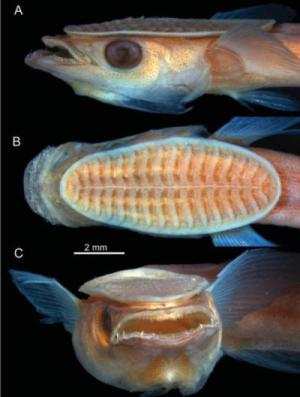We're open daily! View holiday hours
Science News
Sharksuckers
August 7, 2013
by Molly Michelson

Remoras could be classified as freeloaders, having evolved sucker discs on the top of their heads, which they use to attach themselves to their hosts. They hitch a ride on sharks or other large marine animals (rays, whales, turtles), even though they are fine swimmers on their own. They also eat the leftovers or possibly the feces of their host animal. Living on a large animal also protects remoras from predators.
Remoras cause no damage to their shark host, who don’t get much back from remoras, unless sharks find amusement in their oddly upside-down disc-shaped heads. Remarkably, these suckers evolved over time from the fishes’ dorsal fins.
Two recent studies, looking at a fossil remora and remora larvae, have determined how these fins develop over time into a strong sucking device.
The first study, led by Oxford University’s Matt Friedman, examined a 30 million year-old early remora fossil with a fully functioning sucker on its back.
“The remora sucker is a truly amazing anatomical specialization but, strange as it may seem, it evolved from a spiny fin,” Friedman says. “In this fossil the fin is clearly modified as a disc but is found on the back of the fish. It enables us to say that first fin spines on the back broadened to form wide segments of a suction disc. After the disc evolved, it migrated to the skull, and it was there that individual segments became divided in two, the number of segments increased, and a row of spines were developed on the back of individual segments.”
The second study looked at the development of remora from the earliest larval stages and compared it to the larval development of white perch, fish that have typical dorsal fins.
The research team found that up to a certain stage in the fish’s development, the dorsal fin develops in the same way and looks very similar in both fishes. Then, through a series of small changes, the remora’s dorsal fin begins to expand and shift toward the head. By the time the remora has reached about 30 millimeters (1.18 inches) in length, the dorsal fin has become a fully-formed two-millimeter sucking disc. It still has the components found in the dorsal fin—the tiny fin spines, spine bases and supporting bones—but the spine bases have greatly expanded.
The study confirms that the specialized sucking disc is formed by a massive expansion of the dorsal fin through small changes while the fish is developing. This completely new structure is homologous to other fish with dorsal fins and is not an evolutionary offshoot.
Fins turning into suckers? It sounds like a super-power! Well done, remoras.
Image: Dave Johnson, Smithsonian Institution